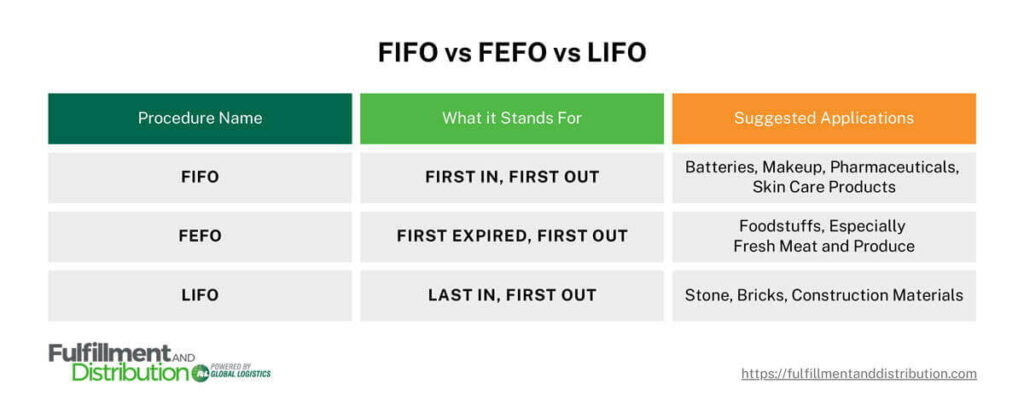
 Copy URL to Clipboard
Copy URL to Clipboard
If there’s one thing that’s true in warehousing, it’s that you need a strategy. The FIFO procedure is one way you can manage your warehouse. Learn more about this method and how to implement FIFO in your warehouse.
Key Takeaways:
Read on to learn about FIFO procedures in warehousing and how they can help your business succeed.
In terms of warehouse management, FIFO stands for First In, First Out. Essentially, when a customer places an order, the oldest stock of that product is shipped out first. The newest inventory stays until the oldest is shipped out to stores or consumers.
This distribution strategy is particularly effective for products that have an extended, but fixed, shelf life. Examples of such products include:
In the most simple terms, FIFO warehousing compares to the method you might use to keep your refrigerator at home organized. When you’re running low on milk, you likely buy a new gallon and place it behind the almost empty gallon. You wait until the old milk is gone before moving the new milk to the front.
FIFO can be a cost-effective method to manage warehouse inventory. It allows retailers and ecommerce businesses to get products to stores and customers quickly, while making sure they aren’t holding onto old inventory.
The FIFO method is often compared to FEFO and LIFO methods of warehousing.
FEFO stands for First Expiring, First Out. With this method, the inventory that expires first is sent out to stores or directly to consumers first. This might be the strategy for you if your products expire quickly. Many certified food grade warehouses rely on FEFO procedures to keep inventory fresh.
Fast-moving consumer goods are great candidates for FEFO warehousing methods. Warehouses storing pharmaceutical products and medicines might take advantage of this procedure to quickly distribute inventory.
LIFO stands for Last In, First Out. In this case, the products that are moved into the warehouse most recently are shipped out first. This means the new stock takes precedence over the old stock.
From a commodity standpoint, this method is only an option for products that don’t expire. Bricks, sand and coal might all be warehoused with LIFO procedures. These products don’t expire and in many cases, the new batch is placed on top of the old batch in the warehouse.
From an accounting standpoint, businesses sometimes use LIFO to calculate their cost of goods sold (COGS) for financial records. Doing so can make a business appear more profitable than it actually is using the more accurate FIFO method under certain circumstances. In fact, LIFO as an accounting practice is prohibited in the European Union, Japan, and several other major economic powers.
The warehousing procedure you choose depends on the products you’re distributing and, to a lesser extent, your preferred accounting practices. With products that have a limited lifespan, FIFO might be the best option. Products move quickly through the warehouse and inventory costs are reduced.
FEFO is also a solid method for expiring products. LIFO only applies to stable goods that don’t apply to any timeline.
For ease of reference, the following table breaks down the essential aspects of these methods and examples of goods to which they can be most successfully applied.

Selecting a method for warehousing depends on the products you’ll be storing. Before settling on FIFO, it’s worth taking the advantages and disadvantages of this method into account.
Pros
There are many benefits of choosing a FIFO procedure for your warehouse, including the five I’ve outlined here.
You might find that FIFO gives a more accurate indicator of the value of your warehouse stock.
Cons
Even though there are many benefits of choosing a FIFO system to manage your warehouse, you might find a few cons depending on your situation. These include:
It is important to weigh the pros and cons when considering choosing a warehousing method. FIFO procedures come with both advantages and disadvantages. Overall, if you’re warehousing goods with an expiration date, FIFO standard operating procedure might be for you.
In most cases, when you’re warehousing products with a limited shelf life, you need a FIFO-specific warehouse management system (WMS) that involves specific procedures during the put away and picking process. Implementing these procedures in your warehouse can be a savvy business move.
One step in implementing FIFO procedures is determining the age of your products. There are several ways you can do this. Consider the following when aging the product in your warehouse:
Overall, creating a FIFO warehouse layout that makes operations more efficient will go a long way toward turning over items faster. The above tips can help you date and age your products so you can easily implement FIFO procedures.
Related: How Pallet In Pallet Out Can Improve Your Inventory Flow
There are a few other considerations to make when implementing FIFO procedures. Things you can do to make the process easier include:
There are a number of different options available to you, including FIFO, FEFO and LIFO. Leveraging the best strategy for your warehouse can help you reduce costs through efficiency.
One of the easiest ways to implement any new warehousing strategy, including FIFO, is by working with a third-party warehouse that stores and ships goods on your behalf. In fact, you may find it beneficial to outsource all of your logistics needs to a 3PL so you can focus on customer satisfaction, marketing strategies, and other business goals. That’s where we come in.
Fulfillment and Distribution can also handle the next step in the supply chain by shipping the freight for you to retailers. With a 99.5% on-time rate and real-time visibility on shipments, we can give you the confidence that your products will be moved quickly.
Our list of logistics services includes:
Call 866-989-3082 or contact us online today to find out how our knowledge, experience, and resources can offer your business the solutions it needs.

request for opening wholesale account